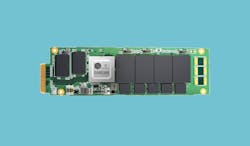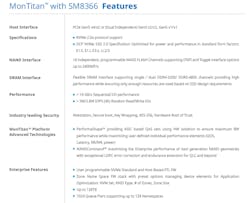New SSD Platform Leverages PCIe Gen 5 NAND Flash Controllers
Check out more coverage of the 2022 Flash Memory Summit.
Silicon Motion rolled out its latest family of NVMe NAND flash-memory controllers to support PCIe Gen 5, promising a boost in performance, reliability, and security for the storage hardware sitting in data centers.
The controllers are key components of the company’s new NVMe SSD platform, called MonTitan, which is ideal for cloud and on-premises corporate data centers that are hungry for more memory bandwidth and performance. Silicon Motion said the massive amount of data being processed in these sprawling server farms is driving the need for faster and higher capacity flash storage, which MonTitan is equipped to handle.
At the heart of the MonTitan platform is the high-performance, Arm-based SM8366 memory controller. The SoC supports NVMe SSD and NVMe 2.0a specifications set by the Open Compute Project (OCP). Manufactured on a 12-nm node, the dual-ported flash-memory controller features up to 4x PCIe Gen 5 lanes that can support a host of configurations, including dual independent x2/x2 interfaces.
According to Silicon Motion, the flash-memory controllers can supply more than 14 GB/s of sequential read/write speed and three million random input/output operations per second (IOPS). The new chip can support up to 16 channels of NVMe NAND flash at data rates of up to 2400 MT/s, double the speed of its predecessor. It can manage a maximum storage capacity of 128 TB, with support for up to 128 namespaces.
The chip contains a single- or dual-channel DDR4-3200 and DDR5-4800 DRAM interface and comes packed in a 21- × 21-mm FCBGA package that fits in U.2, E1.S, and E3.S form factors. The MonTitan family also includes the SM8308, which has the same feature set as its high-end counterpart but can only support up to eight channels of NAND.
A flash-memory controller is a category of special-purpose processors that fit inside SSDs. They are used to communicate with storage when the CPU in the server needs to read, write, or erase data to NAND flash.
More advanced flash controllers are required to stay a step ahead of demand for higher storage capacities and faster performance in data centers, which has dialed up the competition in the category in recent years.
Last year, Marvell Technology rolled out its first family of NVMe NAND flash controllers to support PCIe Gen 5, called Bravera SC5, which will compete with MonTitan. The company said Bravera SC5 is able to supply up to 14 GB/s of throughput and up to 2 million random IOPS, giving it about double the performance of its PCIe Gen 4 lineup. The chips can coordinate up to 16 channels of NVMe 1.4 NAND flash.
“SSD storage solutions are evolving to address new challenges in data centers, which demand changes in storage platforms and operating models,” said Nelson Duann, SVP of marketing and R&D at Silicon Motion.
Silicon Motion is hoping to make a splash with MonTitan. It touted testimonials from several companies that plan to evaluate the platform and potentially use it in their data centers, including Meta and Alibaba.
But the flash-memory controller is only one dimension of the MonTitan platform. The chips are backed by a user-programmable firmware stack and a software development kit (SDK). According to the company, its proprietary “layered firmware” stack opens the door for customers to develop differentiated solutions with a high degree of flexibility and fast time to market, while keeping engineering costs in check.
Silicon Motion said MonTitan also acts as a reference design, giving cloud service providers and technology giants a blueprint to evaluate and integrate the SM8366 into their massive data centers.
Maintaining data integrity and security is a top priority in the data center. Thus, MonTitan includes a hardware root of trust (RoT), secure boot, attestation, AES-256 cryptography, and other security features.
Equipped with the new generation of its LDPC engine, Silicon Motion said MonTitan can plug into and improve the endurance of storage hardware based on a range of flash-memory technologies, including the latest high-density QLC 3D NAND. The platform now works with Kioxia’s 3D BiCS NAND and XL-Flash memory, 176-layer QLC 3D NAND from Micron, and a host of 3D NAND products from YMTC.
Slated to begin sampling in late 2022, MonTitan is “designed to satisfy the unique demands of data centers now while providing flexibility and programmability to meet future evolving standards,” said Duann.
Check out more coverage of the 2022 Flash Memory Summit.
About the Author
James Morra
Senior Editor
James Morra is the senior editor for Electronic Design, covering the semiconductor industry and new technology trends, with a focus on power electronics and power management. He also reports on the business behind electrical engineering, including the electronics supply chain. He joined Electronic Design in 2015 and is based in Chicago, Illinois.


